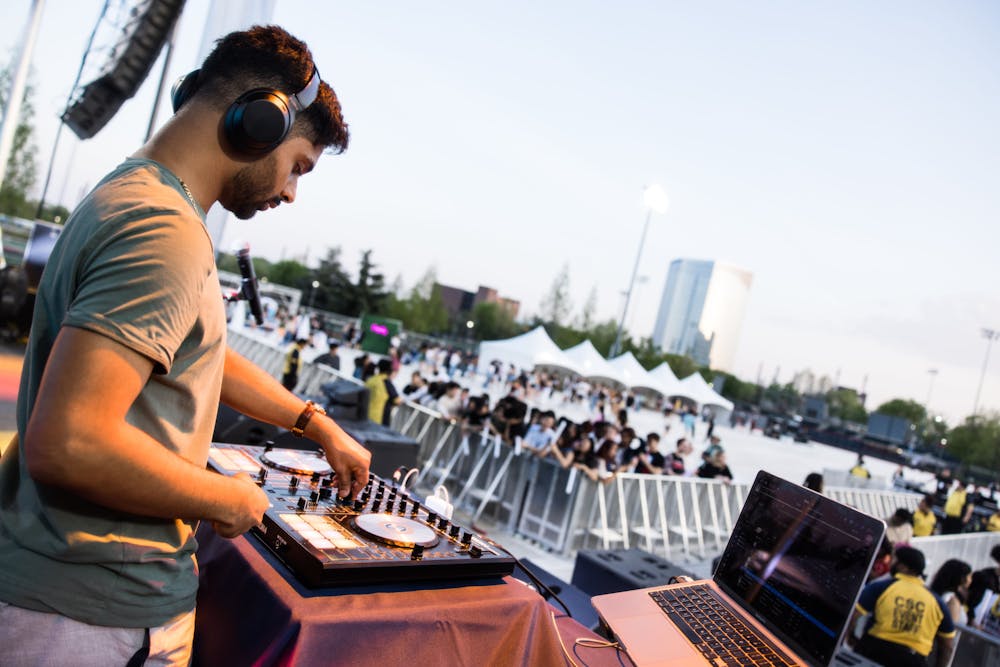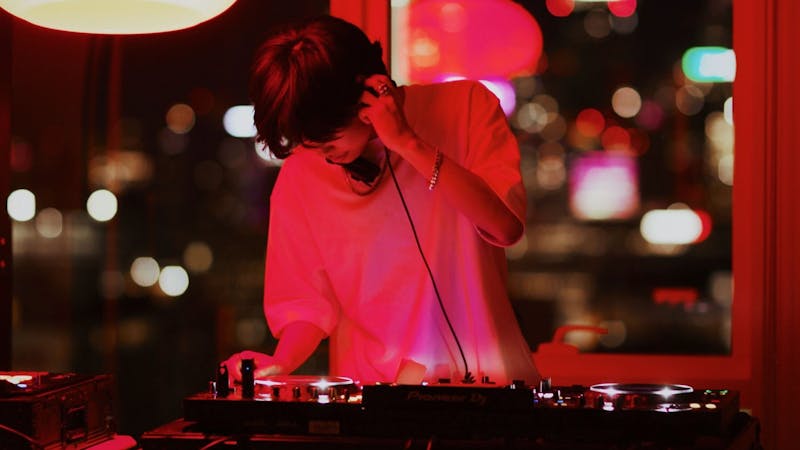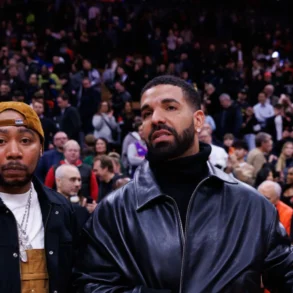It’s 1 a.m., towards the tail end of what began as a normal house party. As the night goes on, most stream out one by one, going home to finish their readings or simply head to bed before the next day’s classes. The chatter dies down, the room empties out, and only a few stragglers stick around, tapping their feet or making idle conversation. The room is cast in shadow, with a solitary blue lamp and the glow of a TV playing “Crazy Realistic Trip Visuals 4K,” the only source of light in the increasingly desolate venue. Through it all, there is only one constant: the DJ standing under the stairs, twisting the knobs, hunched over his decks in furious concentration. The size of the crowd is immaterial, the lack of lighting a mere distraction. In his mind, all that is solid has melted into air—only the sound remains.
Depending on who you ask, the DJ is either a misunderstood artist or a talentless hack. But what is incontestable is the power that they hold at their posts. You see it in their position, standing on their platforms, above the masses who throng together to hear them perform. You feel it in the way that the very room shakes with the pounding of the bass. You know it in the way that their choices can make or break a gathering. A good song can resurrect a flagging party—a bad track can put a live one to rest. Unassuming as they may be in their ordinary lives, behind the deck, the DJ is judge, jury, and executioner, sustaining life or threatening death to any gathering with a single turn of a volume knob. But it takes far more than a deck and frat flicking to make it in the DJ scene. For Penn’s vibrant DJ community, the act is more than a party trick—it’s a serious art and a way of life.

Photo Courtesy of Bobby Cheung
Red lights and a layer of smoke fill the venue with anticipation as Keshav Katti (E ‘22, Ph.D. ‘27)—or, as the DJ community knows him, K3SHV—takes the stage. As the crowd trickles in, Keshav slowly builds the pressure, his uptempo reggaeton beats pounding against the bare walls of the room and bathing the audience in a swell of pure energy. Transition after transition, he barely breaks a sweat, swapping basses and bending genres with a grin plastered on his face.
As we sit down for coffee at Stommons, Keshav seems just as comfortable in an interview as he is behind the decks. But it wasn’t always this easy. “In terms of low points,” he laughs, “there have been a lot.” Before opening for Metro Boomin and Daya at last year’s Spring Fling, Keshav was just another DJ deafening an audience with bass at one of his first shows. He got his start in his bedroom over the pandemic, spending his free time over quarantine picking out songs and practicing transitions. When restrictions on social gatherings were lifted in 2021, Keshav jumped at the opportunity to prove his skills at the many live events popping up around campus.
Fellow DJ Caleb Choi (C ‘26)—&ERSON—has an even longer history on the decks, having picked up DJing as one of many musical pastimes back in high school. Only after coming to college did he begin to dedicate himself to pursuing the art with all of his energy. With a laugh, he tells me frankly that what finally motivated him to take DJing seriously was the glut of subpar music and lackluster performances he saw on display at Penn’s fraternities. If they could do it, why couldn’t he? What Caleb hopes to restore is DJing not as background music to a party, but as its own form of art.
And DJing, they insist, is an art. Even the highest echelon of DJs are often forced to contend with a bad reputation—the term conjures up images of drunk frat brothers mindlessly queuing up “Love Story” on Spotify. But Caleb thinks that a DJ functions as a kind of curator. “We get this question pretty often, what does a DJ actually do? It’s about how you connect songs together to create some meaning, rather than just playing random tracks one after the other,” Caleb says.
The DJ is there to “put people on,” Keshav chimes in. “You need to give your audience what they didn’t know they wanted. It’s being able to read a group of people and change your plans, even throw them out completely, in order to match the energy of the crowd.”
For people like Miles Meola (C ‘25)—DJ Friles—DJing is more than just a performing art. It’s a fulfillment of his purpose. Laying back on his bed as he speaks to me, Miles looks like a Beatle for the modern age, with a full laugh and a mop of shaggy brown hair running down to his shoulders. Coming to Penn, Miles knew he enjoyed going out and meeting new people but struggled to understand what role he played in the broader social fabric: “I was asking myself, Why am I here? What am I here for? When I started going to raves, I realized what I was there for was really the music.” The avant–garde stylings of Philly’s underground house show scene were a stark contrast to the atmosphere at Penn’s frats—it was in these basements, under hot lights and a crush of bodies, that Miles found a home for himself. But he was hardly content with relegating himself to the role of the spectator—his real calling was to make an impact. So he dove head first into DJing himself, finding an old deck in the closet for a student group he was in and practicing in his bedroom whenever he had the time.
It was from this heterogenous patchwork of artists that DJ@Penn—where Keshav is Vice President and Caleb is Director of Events—got its start in fall of 2022. Miles recounts one of the club’s first gatherings, where its founding members met to chat about what equipment they used and their favorite kinds of electronic music. But what began as an informal social group for campus DJs to support each other and sharpen their skills on the deck quickly became much more. From planning performing arts events to working with other student groups and offering equipment (which is often prohibitively expensive) to new DJs who aren’t ready to buy a deck themselves, DJ@Penn today serves as a sprawling hub for amateurs and professionals alike.
“Yeah, we’re a group of DJs who like to hang out together … but how can we now give back to the community?” Keshav asks. “It’s about bringing everyone together and meeting every person’s unique needs.” A particular point of pride for Keshav is the opportunity DJ@Penn gives those interested in learning the storied art, with 70 apprentices having enrolled in their beginner classes this fall.
But DJ@Penn is more than just a training club—for those most committed to the art of the decks, it also serves as a launchpad to a serious career as an entertainer. More recently, the organization has launched its own talent agency for advanced members as a gateway into the industry. Such a pathway is particularly vital in an industry that is notoriously difficult to break into. Miles tells me he felt comfortable DJing for others after about a month of practice in his room. But that led him to another problem—“I was at the point where I was willing to share it with people, but nobody wanted to hear it.” Being a successful DJ is as much about business as it is about artistry. Barring brand–name talent whose star power brings clients to them, most DJs have to actively search for opportunities to prove themselves and build their reputation. Like any other career, a DJ’s network is their net worth, and self–promotion through friends willing to vouch for you is the best way to get early gigs.
But while this decentralized system is useful for those already plugged into a network of performers or venue owners, it can also cause major inefficiencies. DJs lack knowledge of the business side, preventing them from marketing themselves effectively; organizers don’t know what DJs would be best for their unique needs; to DJ@Penn, all of this was squandered potential. “You have really talented DJs on campus, and student groups who are looking for all sorts of different vibes and atmospheres,” Keshav says. “How do we best solve this matching problem?” As a talent agency, DJ@Penn sees their role as connecting both ends of the problem. By linking event organizers with the DJs that best match their needs, DJ@Penn keeps both sides happy: eventgoers get to hear music that matches their vision, while the DJ gets to play the kind of music they want. The organization hopes to take students through every step of the DJ journey, whether taking the plunge into the industry or making that first leap through their training programs.
For many of Penn’s DJs, this first leap into the big leagues is the hardest part. DJ@Penn hopes to fill this gap, acting as a stepping stool for those hoping to gain some initial exposure. Fay Shuai (C ‘25)—FAYZE—got her start DJing private events for her business frat, AKPsi, just last year. Her first big show was just this month Madness and Badness, an event co–hosted by DJ@Penn, the Shea Collective, and Students of Hip Hop Legacy, featuring five of Penn’s most illustrious student DJs. “To be honest, I’m like, shitting myself up there because I’m like, oh my god, I hope the crowd doesn’t know if I mess up or anything,” Fay laughs. “I’m still pretty early on in my journey.” This nervousness, however, was nowhere to be seen in her set, where she regaled the crowd with Brazilian funk and amapiano bangers. “I saw a lot of people shaking their ass in the crowd … That’s like, that’s sick!”
DJing is a deceptively simple art—though turning knobs and pressing buttons may seem easy, there’s far more to the job than meets the eye. I learned this firsthand when, rather than simply write about DJing, I decided to try my hand at the art itself. Standing before a DJ deck for the first time, I feel like a monkey in a shopping mall—stunned, overwhelmed, confronted by a technology far beyond my comprehension. The mechanical monster is Keshav’s, and I’m here for a purpose: to learn the basics of the trade. And I don’t have much time — my first show (Street Design Editor Insia Haque’s birthday party) is in just about a week. After hearing of my unique situation, Keshav told me I could use his equipment—and have his guidance—on the night of the show itself.
Keshav is a seasoned DJ and an equally talented teacher. In addition to leading both introductory and advanced classes throughout the school year, he and Caleb found the time to sit down and offer me advice on what a DJ should and shouldn’t do. First, the DJ is a tastemaker—one of the biggest mistakes that you can make is playing things too safe. “I’ve been to shows that are great, but I leave a little disappointed because I didn’t get anything new out of it,” Keshav says. But this imperative to innovate doesn’t give you license to make your set all about you—listening to and integrating the tastes of audience members is key to your success. “You can see how happy people get when you can blend in their favorite song,” Keshav tells me. “It really means the world to them.” Finally, Caleb advises you keep an ear on not only the quality of each individual track but the totality of your playlist. After all, even the best tracks fray apart without some unifying force to hold them all together. “The technical stuff is a matter of practice,” he tells me, “but the struggle comes with the music—understanding what sounds good together and what doesn’t.”
While viral DJ clips are often replete with flashy transitions or effects, these staples are ultimately just window dressing to the real substance of your set: song choice. “There’s an abstract part of DJing that’s hard to teach,” Keshav says. “It’s being able to curate a set that really captivates an audience.” But the question of how to enthrall a crowd doesn’t have a single right answer. The artistry of DJing lies in how you navigate this abstraction, assembling a set that captures who you are as an artist while still hooking the crowd from beginning to end.
At every show, the crowd asks the DJ a single question—who are you? The ensuing set is the artist’s answer. Caleb’s setlists are the product of a long process of scrounging, probing deep into the newest releases to find the best of any genre “that ends in house.” Keshav’s sets, filled with genres that he broadly calls “world music” (reggaeton, I–pop, etc.), also serve to express his own identity. Shaped by common experiences of colonialism and resettlement that brought disparate populations together, songs by artists in the postcolonial world can come together in a way that both respects each track’s unique origins and speaks to his own experiences as a member of the Indian diaspora, explains Keshav.
But as much as the DJ is a visionary, they lack free license to subject the masses to their sonic whims. Miles’s sage words express this best: “You can’t just play every song that you like. That’s a shitty party, and you’re a shitty DJ.” As a former bartender, Keshav likened DJing to a kind of service work. While there’s an element of artistry to both mixology and live music, creativity can’t become an excuse not to meet your audience’s needs. Some of this work is preemptive—that is, tailoring your set to match what you expect the event to need. But the majority of meeting your audience is a game–time decision—it takes a sharp eye and an even sharper ear, monitoring the situation in real time to ensure that the crowd is always hanging off of your every beat. The discerning DJ straddles a fine line between staying true to their own artistic vision and meeting the needs of their people.
Another way DJs differ is in how they approach the performance itself. Leandra Archibald (W ‘25) —DJADA— experimented with music production as early as high school and draws heavily from her musical roots in her sets. More than anything, she says, her past experience in music has given her good instincts. When it comes to shows, she prefers to do things on the fly, playing what sounds right at any given moment. Her sets—loose, high–energy, free–flowing—reflect that philosophy. “I’ll plan, like, the first five tracks of a set,” she says, “and then feel out the rest, and people will still think it’s a great show.”
The energy Leandra brings to every gig drives home an important point—DJing is a performance art, and just as important as the music itself is the way each performer interacts with the crowd. Some do this through presence alone, exuding confidence up on the stage. Others tweak their setlists to showcase their personalities—Fay, for example, uses Spongebob audio cues during her set to inject a comic element into her performance.
DJing is too often reduced to a purely mechanical act—after all, how much room for subjectivity is there when it comes to buttons, knobs and electrical impulse? But this misses the point entirely—any tool is only as good as its wielder. The DJ is there to breathe content into dead form, weaving connections between tracks to bring out new ideas and going beyond the music to animate the crowd through their very presence.
Interior. Radian apartment. My DJ debut.
You always remember your first. At least, that’s what I was told. The crowd is small, 15 people at most, and the venue even smaller. Keshav and I set up in the kitchen, with his deck spanning nearly the entire length of the countertop and leaving a tangled mess of wires on the floor behind us. From the start, things are going wrong. I’m screwing up bass swaps, failing to beatmatch and forgetting the basics I thought I had down. The crowd, rowdy and honest, boos loudly every time I make a mistake. I’m losing them. But just as it all seems lost …
Keshav steps in.
Watching Keshav man the decks feels like seeing a captain guide his vessel through rocky waters. Just as a song seems to overstay its welcome or lose the audience’s attention, he veers into another track, steering our ship away from certain doom. Though conversations abound around him, no sound can turn his attention from the task ahead of him. With steel in his eyes, he cues up tracks, swaps basses and executes transition after perfect transition. A master of the music, Keshav is just as at home here, crammed behind the countertop of a Radian suite as he is in a real club—all he needs is his deck and an audience (however big or small) to make it all work.
DJing isn’t a career for the faint of heart. It takes work, and grit, and perseverance—but more than anything else, it takes a vision. Whether it’s &ERSON’s deep house sets, DJADA’s hip–hop stylings, or FAYZE’s Brazilian funk–fueled odysseys, no two DJs are alike, from the music they play to the way they harness the energy of the crowd. What they all share, however, is a spirit of innovation and a desire to make the songs they play their own. As the crowd thins and he packs his equipment away for the night, Keshav recalls with fondness the long journey that brought him to where he is today. Despite every setback, he says, “every gig only gets better.”
More Like This
This post was originally published on this site be sure to check out more of their content.







